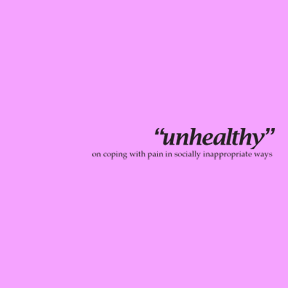Feminists organizing against domestic and sexual violence generally use the word “survivor” instead of “victim” to refer to people who experience violence (unless, of course, the person is murdered, in which case the term “survivor” obviously does not apply). “From victim to survivor” (and even “to thriver” sometimes) is a model often invoked by people who are working to heal and empower victims/survivors of abuse as well as by the victims/survivors themselves.
I myself have used the word “survivor” for many years. But as I began questioning “survivor” narratives and exploring negative survivorship as a compelling alternative to the cult of compulsory hopefulness and optimism in the “trauma recovery industry,” I came to identify with and embracing the term “victim” more. I never felt that I survive well enough to call myself a survivor anyway.
Many people prefer the word “survivor” to “victim” because “survivor” feels strong and proactive. I understand that, as that is precisely how I felt for a long time also, but I am starting to think that we need to honor and embrace weakness, vulnerability, and passivity as well, or else we end up blaming and invalidating victims (including myself) who do not feel strong some or most of the times.
The society views victimhood as something that must be overcome. When we are victimized, we are (sometimes) afforded a small allowance of time, space, and resources in order to recover–limited and conditional exemptions from normal societal expectations and responsibilities–and are given a different set of expectations and responsibilities that we must live up to (mainly focused around getting help, taking care of ourselves, and recovering). “Healing” is not optional, but is a mandatory process by which a “victim” is transformed into a “survivor”; the failure to successfully complete this transformation results in victim-blaming and sanctions.
This is the so-called “victim role,” an extension of sociologist Talcott Parsons’ theory of “sick role.” The society needs victims to quickly transition out of victimhood into survivorship so that we can return to our previous positions in the heteronormative and capitalist social and economic arrangements. That, I believe, is the source of this immense pressure to become survivors rather than victims, a cultural attitude that even many feminist groups have internalized.
This victim-to-survivor discourse is a common theme in the trauma recovery services/industry. A self-help website, for example, states:
This section is about moving from Victim-To-Survivor.
This is an action step, and a change in mentality.
Yes, you are a victim of sexual abuse, but a victim stays in a victim role and never moves further and changes any behaviors that might change the outcome of the feelings that you are suffering from.
You can’t change what happened to you… but you CAN change how you will react to it and how you want your life to be from this day forward!
Once you make the decision to recover, you have the power to change your life!!
Your abuser does not have to win! You can take back your power and move on and not stay stuck where you are!
Hence, victimhood is construed as static and uncomfortable. Being a victim means that the abuser has won, and the victim is left without any “power” and is “stuck” where she or he is. The only hope for the victim is not a revolution, or community accountability and care, but “a change in mentality.” I find this rhetoric overly apolitical, individualistic, and victim-blaming.
Such messages are not uncommon. Another examples is a recent (10/26/2011) “expert blog” article on Mayo Clinic website, which is ironically titled “Victim or survivor? It’s your choice.” When I first saw the title, I thought the article was about how we as victims and survivors get to define our own experiences. but it wasn’t. Because the author is an oncologist, I assume that it is an advice intended for cancer survivors–but the article itself does not make that explicit, and his comments feels very similar to things people say to victims/survivors of domestic and sexual violence.
Everyone has setbacks, disappointments and frustrations. But the way you respond to these challenges and opportunities is what defines you. Whether you become a victim or a “seasoned survivor” depends on your attitude and the way you view the setback.
When faced with an overwhelming crisis, whether personal, spiritual or financial, your circuits can be overloaded. You may feel paralyzed. However, once a little time has passed, you can marshal your options to creatively deal with the problem.
Whatever has happened, you can choose to whine and complain about it, or to profit and learn from the experience. Whining is not only unproductive, it also pushes away your support network. Friends and colleagues will listen for just so long, but then it is time to move on. The choice is yours. Your life depends on it.
Once again, victims who “whine and complain” are blamed for causing their own suffering by pushing away our support networks, as if our mentality is the only barrier for us victims/survivors to thrive. While the author pretends to offer “choices,” he is clearly promoting normative survivorship over “unproductive” whining and complaining, blaming those of us who remain “victims” for failing to live up to our societal expectations.
I argue that feminist anti-violence movements and communities must embrace unproductive whining and complaining as legitimate means of survival in a world that cannot be made just by simply changing our individual mentalities. We must acknowledge that weakness, vulnerability, and passivity are every bit as creative and resilient as strength and activeness. And I think we can start that by reclaiming “victim” and “victimhood” and resisting the heteronormative “victim to survivor” discourse of the trauma recovery industry that imposes compulsory hopefulness and optimism in the service of neoliberal capitalist production.


